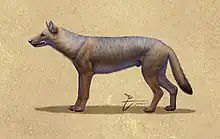Theriodictis
Theriodictis is an extinct genus of hypercarnivorous wolf-like canid endemic to South America during the Pleistocene, living from 1.2 Ma- 500,000 years ago and existing for approximately 0.7 million years. [1][2][3]
| Theriodictis | |
|---|---|
 | |
| Fossil skull in the Museo Malvinas e Islas del Atlántico Sur, Buenos Aires, Argentina. | |
| Scientific classification | |
| Domain: | Eukaryota |
| Kingdom: | Animalia |
| Phylum: | Chordata |
| Class: | Mammalia |
| Order: | Carnivora |
| Family: | Canidae |
| Subfamily: | Caninae |
| Tribe: | Canini |
| Genus: | †Theriodictis Mercerat, 1891 |
| Species | |
| |
Fossil distribution
The fossil remains are confined to the Tarija Formation of Bolivia, the Chui Formation of southern Brazil, and the Yupoí Formation of northern Argentina.[4][5][6] The species T. tarijense was transferred to the genus Protocyon upon phylogenetic analysis.[2]
Description

It was a large sized canid; body weight for adult specimens of Theriodictis platensis has been estimated at around 30 to 40 kg. The dental diagnostic trait is found in the hypocone of M1 which is reduced in comparison with that of other genera.[7]
Paleoecology
Prey is thought to have included ungulate camelids (e.g. guanaco), cervids (e.g. Epieurycerus and Antifer), equids (e.g. Equus and Hippidion), peccaries (e.g. Catagonus), giant rodents (e.g. Neochoerus), mesotherids (e.g. the burrowing Mesotherium), and giant cingulates (e.g. Eutatus, Propraopus and Pampatherium).[8]
References
- http://paleobackup.nceas.ucsb.edu:8110/cgi-bin/bridge.pl?action=checkTaxonInfo&taxon_no=41213&is_real_user=1%5B%5D Eucyon: Basic info.
- Prevosti, Francisco J.; Forasiepi, Analía M. (2018-01-02). Evolution of South American Mammalian Predators During the Cenozoic: Paleobiogeographic and Paleoenvironmental Contingencies. Springer. ISBN 9783319037011.
- Chichkoyan, Karina Vanesa; Figueirido, Borja; Belinchón, Margarita; Lanata, José Luis; Moigne, Anne-Marie; Martínez-Navarro, Bienvenido (2017-05-09). "Direct evidence of megamammal-carnivore interaction decoded from bone marks in historical fossil collections from the Pampean region". PeerJ. 5: e3117. doi:10.7717/peerj.3117. ISSN 2167-8359. PMC 5426367. PMID 28503369.
- Theriodictis at Fossilworks.org
- Rodrigues, P.H.; Prevosti, J.F.; Ribeiro, A.M.; Ferigolo, J. (2004) Novos materiais de carnívora para o Pleistoceno do Estado do Rio Grande do Sul, Brasil. Revista Brasileira de Paleontologia, v.7, n.1, p.77-86, 2004.
- Ribeiro, A. M.; & Scherer, C. S. (2009) do Pleistoceno do Rio Grande do Sul. In: Quaternário do Rio Grande do Sul: Integrando conhecimentos. Monografias da Sociedade Brasileira de Paleontologia. Porto Alegre: Ana Maria Ribeiro, Soraia Girardi Bauermann, Carolina Saldanha Scherer (Org.). Sociedade Brasileira de Paleontologia, 2009. p. 171-191.
- Perini, F. A.; Russo C. A. M.; and Schrago C. G. (2010) The evolution of South American endemic canids: a history of rapid diversification and morphological parallelism. J. Evol. Biol. 23, 311–322.
- F.J. Prevosti; P. Plamqvist, 2001, Ameghiniana 38: 375-384